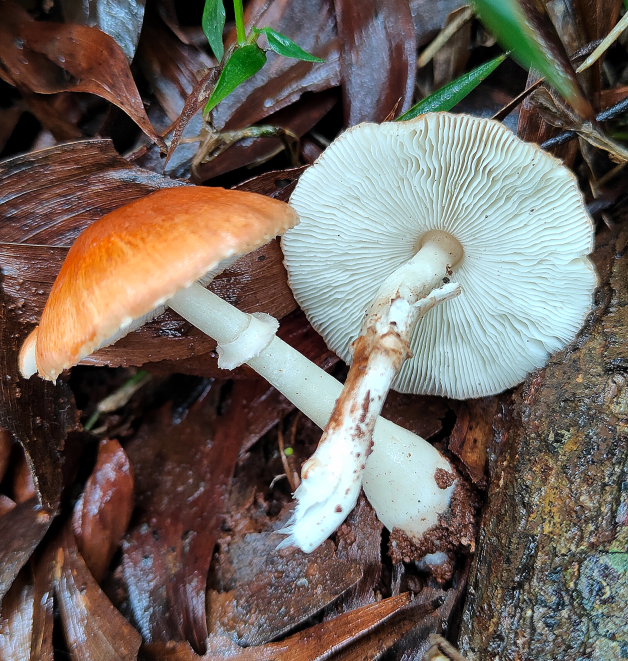Pileus 1.5-4 cm in diameter; ovoid then conical at young, flat to concave when mature; white, covered by small, red, radially arranged scales, dark reddish brown in the center; surface dry and rough; margin straight, entire. Lamellae white, free, thick, with lamellulae, not bruising or staining when handled. Stipe 4-10×0.2-0.4cm, white, cylindrical, solid, smooth, central, fibrous; annulus central, ascending, equal; club-shaped base. Annulus on the upper stem, with slightly reddish-brown edge. Trama white and consistent. Basidiospores 5.1-9 x 3.2-5.4 µm, ellipsoid, smooth, thick-walled, hyaline; germ pores absent. Spore print white. Basidia 16-24.5 x 6.5-8 µm, hyaline, claviform and tetrasporic. Pleurocystides not observed. Cheilocystidia 18-32 x 6.8-9.2 µm, hyaline, subclavate, polymorphic, fusiform-langeriform, ventricose.
Specimens examined
India, Maharashtra, Kolhapur, Bhudargad, Bediv, (16°25ʹ03ʺN-74°02ʹ14ʺE), on ground, alone, solitary, 14.06.2020, Bornak S.I. (Y20V2C2); Panhala, Pombare (16°43ʹ01ʺN-73°55ʹ56ʺE), on soil, amongst decaying litter, solitary 26.06.2022, Bornak, S. I. and Patil, Y.S. (Y22V5C6).
Remarks
Leucoagaricus rubrotinctus is recognized byreddish to brown to orange pileus, remaining dark brown in the center. In young specimens, pileus shows uniform colour which, when maturing gives the impression of small radial scales on a pale background. Basidiospores with an inconspicuous to absent germ pore (Ferreira and Cortez, 2012). Leucoagaricus rubrotinctus shows similar morphology with Lepiota rubrotinctoides Murrill, but differs from Leucoagaricus rubrotinctus by smaller basidiospores (7 x 3.5 µm), lack of pileal scales and larger basidiomata (Murrill, 1912). Another similar species is Leucoagaricus glabridiscus (Sundb.) Wuilb., however it is a smaller and fragile macrofungi, with a double layer of interwoven hyphae that forms the pileus covering (Kumar and Manimohan, 2009a; Verma, et al., 2018). Leucoagaricus rubrotinctus is distributed in Mangalore, Karnataka; Idukki, Kozhikode, Karulai, Malappurum, Kollam, Nilambur, Kuthiran, Muthanga, Thrissur, Peechi, Wayanad in Kerala and Jabalpur, Madhya Pradesh (Verma, et al., 2018). Trivedi (1972) reported this species as Lepiota rubrotincta from Nagpur, Maharashtra. This is a new report from the study area.
References:
Ferreira, A.J. and Cortez, V.G. (2012). Lepiotoid Agaricaceae (Basidiomycota) from São Camilo State Park, Paraná State, Brazil. Mycosphere, 3(6):962-976; doi: 10.5943/mycosphere/3/6/11.
Murrill, W.A. (1912). The Agaricaceae of the Pacific Coast – II. White and ochre-spored genera. Mycologia, 4(5):231-262; doi: 10.2307/3753448.
Kumar, T.K.A. and Manimohan, P. (2009). The genera Leucoagaricus and Leucocoprinus (Agaricales, Basidiomycota) in Kerala State, India. Mycotaxon, 108:385-428.
Verma, R.K., Vimal, P., Asati, H.L. (2018). Diversity of macro-fungi in Central India-XII: Leucoagaricus rubrotinctus. Van Sangyan. 5(4):2-11
Trivedi, T.K. (1972). Agaricales of Nagpur-I. Botanique, 3(1):53-59.








